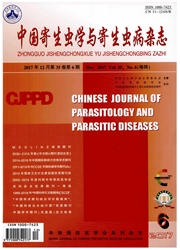

 中文摘要:
中文摘要:
目的 基于内转录间隔区(ITS)序列, 建立鉴别3种感染白牦牛线虫的PCR-限制性片段长度多态性(PCR-RFLP)方法。方法 将从甘肃省天祝藏族自治县1头白牦牛小肠中分离的12条线虫进行消化并提取DNA, PCR扩增ITS序列并送测序, 测序结果在GenBank数据库进行同源性分析。用DNAstar7.1软件分析序列之间的差异, 用邻接(NJ)法构建系统进化树。根据序列选择特异的酶切位点, 对PCR产物分别进行酶切反应, 建立PCR-RFLP方法。结果 12条线虫均扩增出长度约900 bp的ITS序列片段, 与预期结果一致。测序结果同源性分析显示, 其中3种各4条分别与已报道的肿孔古柏线虫(Cooperia oncophora, GenBank登录号为AB534601)、环纹背带线虫(Teladorsagia circumcincta, GenBank登录号为JF680984)、奥斯特线虫(Ostertagia sp., GenBank登录号为HQ844228)的序列相似性高于99%。ITS序列比较发现, 3种线虫种间差异为4.3%~13.9%, 种内差异均低于1%。其中肿孔古柏线虫与奥斯特线虫的ITS序列差异最大, 为13.6%~13.9%; 肿孔古柏线虫与环纹背带线虫ITS序列差异为12.9%~13.1%; 环纹背带线虫和奥斯特线虫ITS序列的差异最小, 为4.3%~4.8%。系统进化树结果显示, 3种线虫被分为明显的3支, 且环纹背带线虫和奥斯特线虫有更近的亲缘性。ITS序列酶切结果显示, NdeⅠ酶可将环背带线虫和肿孔古柏线虫的ITS序列酶切成约650 bp和250 bp的片段, EcoR Ⅴ酶仅将肿孔古柏线虫酶切成约700 bp和200 bp的片段, 2种内切酶均不能酶切奥斯特线虫的ITS序列。 结论 建立的基于ITS序列的PCR-RFLP方法可鉴别感染白牦牛的肿孔古柏线虫、环纹背带线虫、奥斯特线虫。
 英文摘要:
英文摘要:
Objective To develop the polymerase chain reaction (PCR)-restriction fragment length polymorphism (RFLP) method based on internal transcribed spacers (ITS) of ribosomal DNA to identity three nematode species that infected a white yak. Methods Twelve nematodes were collected from the small intestine of a white yak in Tianzhu Tibetan Autonomous County, Gansu Province, and DNA was extracted. Then the ITS region was amplified by PCR and sequenced. The sequences were analysed by DNAstar7.1 software and the phylogenetic tree was constructed by the neighbor-joining (NJ) method. Specific sites for restriction endonucleases were identified, based on which the PCR products were digested, and the PCR-RFLP method was established. Results PCR resulted in specific ITS bands of 900 bp for all the 12 nematodes. Sequencing results showed that each was approximately 900 bp in length. The sequences of 4 of the 12 nematodes had sequence similarity of 〉 99% with Cooperia oncophora (GenBank accession number AB534601), Teladorsagia circumcincta (GenBank accession number JF680984), and Ostertagia sp. (GenBank accession number HQ844228). However, the interspecies difference in ITS sequence among the three species was 4.3%-13.9%, while the intraspecific difference was 〈 1%. The interspecies difference in ITS sequence was most significant between C. Oncophora and T. circumcincta (12.9%-13.1%), medium between C. oncophora and Ostertagia sp. (13.6%-13.9%), and the least between T. circumcincta and Ostertagia sp. (4.3%-4.8%). The phylogenetic tree grouped the three nematode species into three branches, and revealed a closer ralationship between T. circumcincta and Ostertagia sp. PCR-RFLP analyses showed that the ITS sequences of C. Oncophora and T. circumcinctais were cut into fragments of 650 bp and 250 bp with endonuclease NdeⅠ, while only the ITS sequence of C. oncophora was cut into fragments of 700 bp and 200 bp with EcoR Ⅴ. The two endonucleases were ineffective for the ITS sequences of Os
 同期刊论文项目
同期刊论文项目
 同项目期刊论文
同项目期刊论文
 期刊信息
期刊信息
